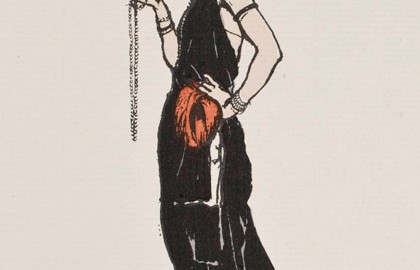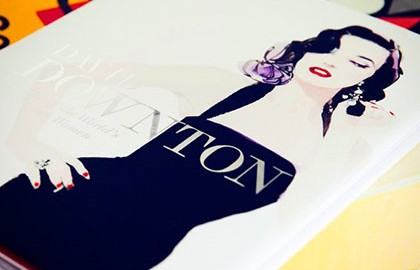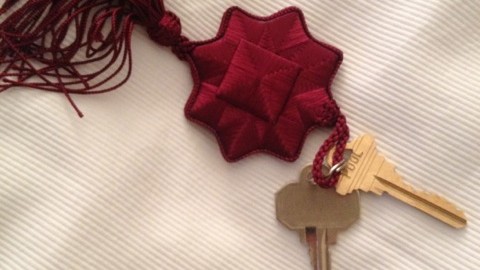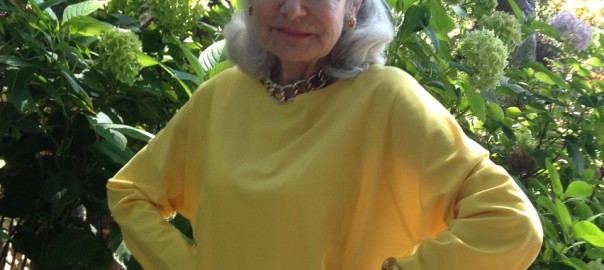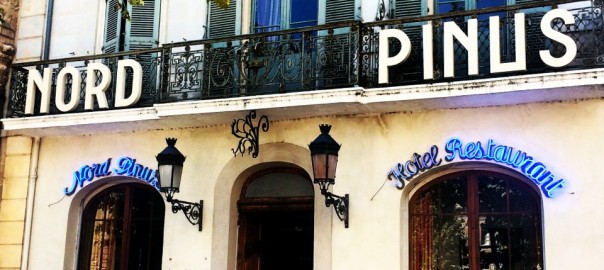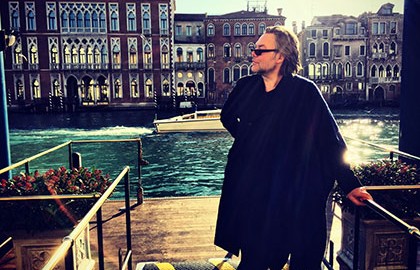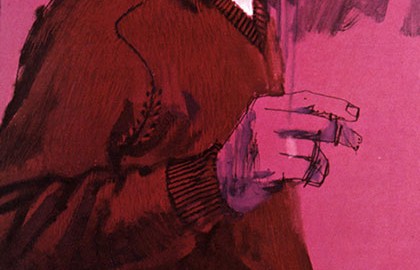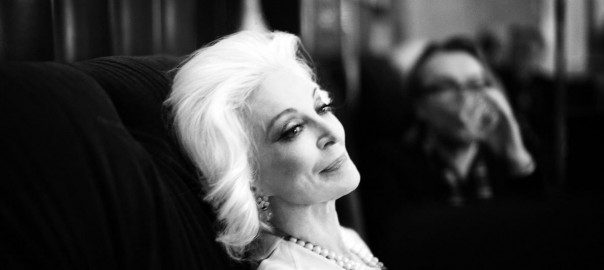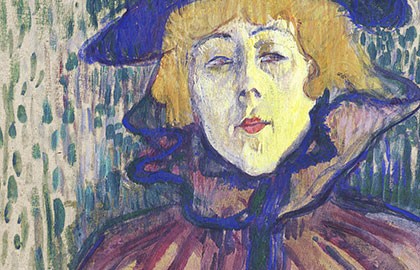“To me he is the greatest… a span ahead of all the others: Eric, Lepape, Marty, Benito,” so said René Gruau – the master – of Etienne Drian (1885 -1961).
I agree. Of all the fashion artists who rose to prominence in Paris before World War 1, Drian was the most restrained. Or perhaps I should say the most refined. As Marty, Barbier and Lepape embarked on ever more daring experiments with colour, perspective and surface design, Drian drew what he saw. Working from life, his models were notable for their elegant – but distinctly flesh and blood – beauty. As his peers embraced Orientalism and dreams of 1001 nights, Drian explored the inherent possibilities of line. In many ways, his gestural brushwork and grand manner made him a link between Boldini and Gruau. Drian was also a superb graphic artist. His series of drawings (seen here) designed to raise morale for a special wartime issue of the magazine ‘Gazette du Bon Temps’ in 1915 are masterpieces of storytelling. He worked for the major publications of the day, designed murals, furniture and window displays, and illustrated novels and fairy tales. In the latter part of his career, he became known principally as a portrait painter, living in high style. (One of his subjects, the Duchess of Windsor, would buy his country home, Moulin de Tuilerie, near Paris.) Above all, Drian was a draughtsman of dreams.
“It’s only a movie, Ingrid,” Alfred Hitchcock famously intoned as Ingrid Bergman fretted over her character’s motivation. Well maybe, but it is never “only a book.” Right now, authors with a Christmas title to sell are stumbling out of hibernation ready for the headlong canter to the finish line: Amazon’s last day of shipping before the holidays. From the gaudy talk show chatterthon – if you are famous enough – to the lonely, regional book-store signing, it is all grist to the mill. And no opportunity must be missed. The reason, of course is that books take over your life, dragging you and your loved ones into a swirling vortex from which there may be no return. Taking my own magnum opus, Portraits of The World’s Most Stylish Women, to market has led me from Perth in Western Australia to San Francisco, via London, LA, New York and Rome. In London, Dame Joan Collins presided over a room full of fashion week glitterati, and raised a glass to her late sister, Jackie. In New York, Vanity Fair’s Graydon Carter threw a bash at The Waverley Inn attended by Carolina Herrera, Harvey Weinstein, Christine Baranski and my great friend Carmen Dell’Orefice. In San Francisco, Dita Von Teese arrived with a platinum blonde doppelgänger and master corsetier, Mr Pearl, and sipped a cocktail named after her from under a veil. Heady stuff. I‘ve talked and signed and signed and talked and been as charming as I can muster for weeks. But the end is in sight. With 2016 comes a new page and the realisation that perhaps, after all, it was only a book.
Sometimes hotels don’t disappoint. Walking into the Chateau Marmont on Sunset Boulevard – the epicentre of louche Hollywood since it opened in 1929 – there is a sense that everything is exactly as it should be. “Welcome to the Chateau,” says the best looking guy not currently in the employ of Bruce Weber. Take the lift (it is so dark that might not be your companion) to the first floor lobby where the tiles are black and polished, the velvet plush and the mirrors cloudy and opaque. In the courtyard, dappled shade offers discreet cover to Hollywood deal-makers and pleasure seekers. Today, at a glance, Dita Von Teese, Willem Dafoe and Stephen Fry. “Welcome to the Chateau,” says the best looking girl as yet undiscovered by Ellen Von Unwerth. Outside, the oval pool is Hockney blue and half hidden in a thicket of Eucalyptus, banana palm and bamboo. Around it, a cluster of wooden cottages, blinds drawn; above, two Gucci odalisques watch implacably from a giant billboard, keeping their secrets, and yours. “If you are going to misbehave, do it at the Chateau Marmont,” said movie mogul Harry Cohn in 1939, and generations of bad boys and bohemians have heeded his advice ever since. Legends cling like vines. There have been dark currents as you might expect in such a charged atmosphere, but the mood today is elegiac, woozy. Maybe it’s a real chateau after all, or is it the light?
Every summer, Denise Hale, San Francisco’s legendary arbiter of style and orchestrator of the social scene, throws a party for 20 or so of her best gentlemen friends. That’s not an invitation to be lightly refused and last weekend I found myself at Mrs Hale’s ranch, an 80,000 acre slice of Nirvana in Sonoma County, Northern California (80,000 acres by the way is pretty much everything you can see, as far as you can see it). The ‘H-E’ is a working cattle ranch and its recently acquired organic status has put an extra gleam in our hostess’ eye. The ranch house, a sprawling structure dating from 1950 is imbued with an undeniably European sensibility (Mrs. Hale was born in Belgrade and lived in Rome before arriving in San Francisco, via Beverly Hills). Outside, marble tables from Agra are laid with silver and set among hydrangeas that have been taught to droop gracefully ‘in the Chinese style’. “I’m a mess,” announces Ken Fulk, SF’s go-to interior designer, looking like Jay Gatsby on a Long Island lawn.
Mrs Hale enjoys high-powered company; if it is attentive, attractive and male, so much the better. Today, sporting a bracelet Mike Tyson couldn’t lift unaided – a gift from her late husband – she is in full bloom. After margaritas and champagne, a feast whipped up by master chef Gary Danko lasts until evening. The stars are out, the silence is enveloping. Gregory Lopez is pouring Tequila shots. Only the brave do a lap of the pool, knowing they will share it with at least one of Mrs Hale’s German Shepherds. Shoeless and feeling no pain I find my way back to my guest–house by flash-light, unperturbed by the mountain lion that stakes out the tennis court.
Of course Mrs Hale throws a swell party (she is a veteran of Capote’s black and white ball and every notable gathering you have and haven’t heard of since) but only an alchemist can turn the middle of nowhere into the centre of everything. All hail Mrs Hale!
The Rencontres, the largest international festival of photography in the world is reason enough to visit Arles this summer. If you are feeling adventurous, go during the Feria du Riz (early September), a rambunctious celebration marking the harvesting of the rice crop. Then too, there is the ghost of Van Gogh who produced 300 paintings the year he lived at the Yellow House (when you think of Arles, isn’t it his Café de Nuit that ravishes your mind’s eye?) and a dazzling tribute to Picasso by Christian Lacroix (a local son) at the Musée Réattu. Fiercely independent, Arles is one town in Southern France where you don’t need a degree in Russian to read a road sign or daydream at an estate agent’s window.
Best of all is the chance to stay at the Grand Hôtel Nord-Pinus. Standing sentinel in the Place du Forum, this is a hotel that wears its legend lightly. In the 50s and 60s it paid host to Picasso and Cocteau, to Callas and Chaplin, to Huston and Hemingway before drifting into a melancholy decline. It was rescued a decade or so ago by the current proprietor, Anne Igou, who has orchestrated a sublime transformation. For Mme Igou has an artist’s eye and a collector’s instinct. Everything, from the museum quality photography by Peter Beard and Peter Lindbergh to the Berber rugs and 30s armchairs is pitch perfect but thankfully not too perfect. It is a hotel for travellers, for romantics and for Nomads de Luxe, and is a glorious rebuke to corporate greige and TripAdvisor bores. It is, in other words, an Hôtel de Rêve.
I’m not saying I’m a republican, but I made a bid for freedom over the recent Jubilee festivities and flew to Venice with the firm intention of ‘doing some painting’. Arriving in a thunderstorm with a sky the colour of squid ink and the lagoon an opaque green marble prompted a rethink and a long lunch. The next day’s sun and light breeze might have been ideal for working ‘en plein air’, but by then I had a list of exhibitions to see; Picasso’s Vollard etchings, Klimt’s darkly glittering portraits and sketches, and an homage to Diana Vreeland at the magnificently melancholy Palazzo Fortuny. Culture needs considering, so afterwards I headed to Harry’s Bar, via the Caffé Florian, to take stock. More displacement activity followed; you can’t go to Venice without visiting the Peggy Guggenheim collection. Her Palazzo Venier dei Leoni on the Grand Canal houses the self-confessed art addict’s 20th century master works. I am no fan of her long-term paramour Max Ernst, but the Motherwell, the Klee, the Picasso and the Henry Moore in the sculpture garden are their own reward. So it continued and by the end of my stay I still hadn’t put pen to paper. Instead, I turned to the late artist Glynn Boyd Harte’s beguiling book on Venice which encapsulates everything I had intended to do, better than I could ever do it.
Let joy be unconfined! Mad Men is back and, for obsessives like me, there could be no better news. The fifth series finds Don Draper still king of the ring and sharing a Manhattan penthouse (Don was never at ease in suburbia) with his Jane Birkin-esque bride, Megan. She’s the kind of girl who strips down to her underwear to do the housework. His three children, including the troubled and troubling Sally, are usefully out of sight and out of mind with his former wife Betty, who has put on weight and lost her Grace Kelly glow. Pete, the agency’s rising star, still has his eye on the prize; becoming Don (everyone wants to be Don, except Don) while Roger, the man crush of every man I know, pauses between Martinis just long enough to deliver the show’s best lines. And then there’s Joan. Joan with her surprising swan neck and dimpled chin. Joan with the seaside rollercoaster curves. Joan who walks to her own drum roll. I could go on, but maybe this means nothing to you. You are probably watching the Apprentice and Masterchef and Britain’s Got Talent. Let’s not meet. We have nothing in common.
If the longuers and the calibrated torture of Mad Men’s pacing is too much (I suspect MM appeals to masochists the same way the Sopranos appealed to sadists) then allow me to introduce the instant, eye-popping high of Bob Peak’s masterful illustrations (below). Peak was a real life Madison Avenue man, arguably the most successful commercial artist of the 50s and 60s. He was also my childhood hero. I copied everything I could find. Growing up in rural Kent, Peak’s imagery conjured an alien world of glamour and sophistication where the Rat Pack ruled, leisure wear was king and smoking went with everything. How Mad Men is that?
This has been a banner year for my friend, modelling super-legend Carmen Dell’Orefice; she turned 80 in June, was made an Honorary Doctor by the University of the Arts in July and has kept up the kind of work schedule in the interim that would give a teenager pause. Last week Carmen: A Life in Fashion, an exhibition charting her unique 66 year career, opened at LCF’s Fashion Space Gallery. You need to go and see it. It was my first attempt at curation. A labour of love to be sure, but what’s not love when the images are master works by Avedon, Penn, Parkinson, Beaton, and Skrebneski? London College of Fashion hosted not one but two celebratory events, attracting London’s boldest bold face names.
After Wednesday night’s party it was a case of “all back to my place” for Erin O’ Connor, Philip Treacy, Selina Blow, Hannah Marshall, Leanne Wierzba (of the Fashion Space Gallery) and photographer Tim Petersen who had flown in from New York for the occasion. My place of course is the super salubrious and super sexy Fumoir bar at Claridge’s, which doubles as my London office. Matinee idol barman George served drinks until 3am, Carmen and Philip fashioned a hat out of nowhere and the self-effacing but quietly brilliant Mr. Petersen – for whom the term stealing beauty might have been invented – recorded the whole thing. Tim’s images prove (did we doubt it?) that Carmen is a beauty for the small hours as well as the ages.
Toulouse-Lautrec was a master of design, an architect of celebrity, a dazzling image-maker. Was there ever an artist so tender or so trenchant? He may have been enthralled by women, by sex and by the bohemian life of Montmartre but he never lost his coolly appraising eye. Toulouse-Lautrec and Jane Avril, Beyond the Moulin Rouge at the Courtauld in London explores his relationship with the dancer Jane Avril. The iconic works are there; Avril high kicking amid a swirl of orange and yellow skirts, Avril in the audience of the Divan Japonais, an inky, sinuous silhouette, Avril apparently succumbing to a serpent that coils around her dress as she sings. Nor does Lautrec shy away from the flip side of celebrity. Off stage he depicts her as distracted, isolated and more than a little careworn, especially considering she was only in her twenties during their collaboration. The exhibition reminds us not only of the artist’s sublime skill, but also of the debt that every fashion illustrator owes him, from the great mid-century glamourist René Gruau, to today’s pre-eminent observer of the scene, Gladys Perint Palmer. Go and see it.
